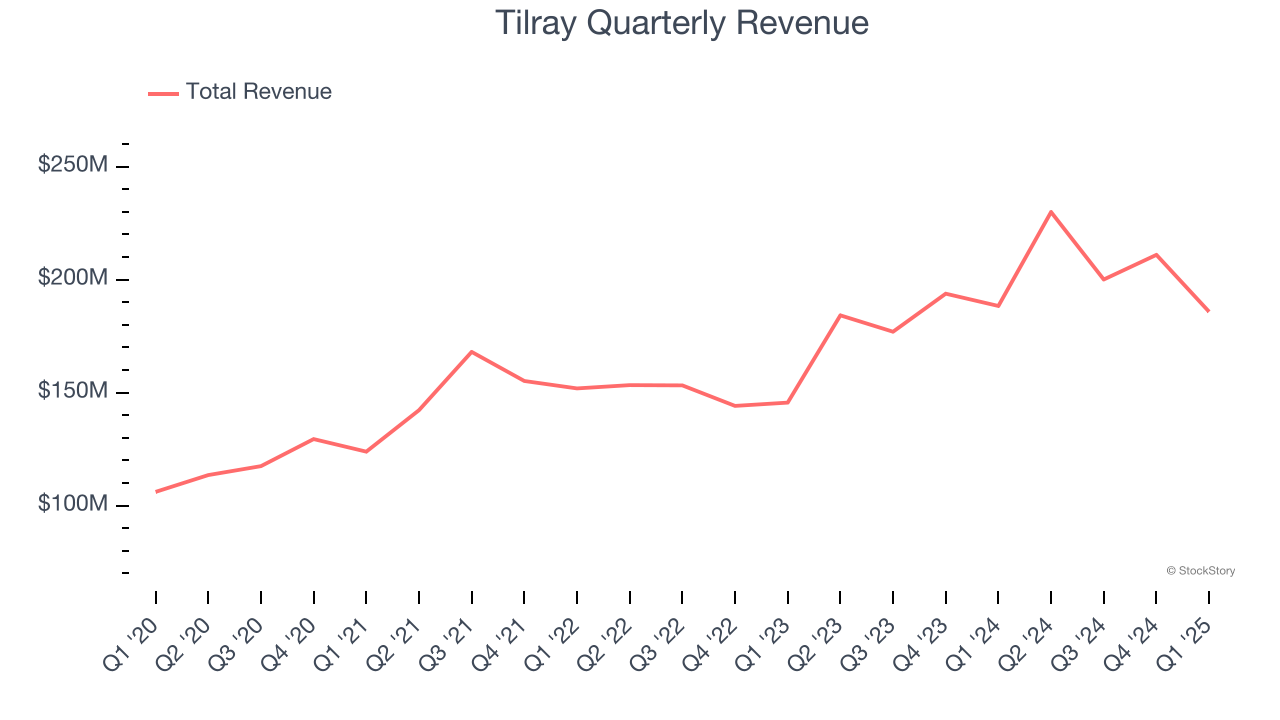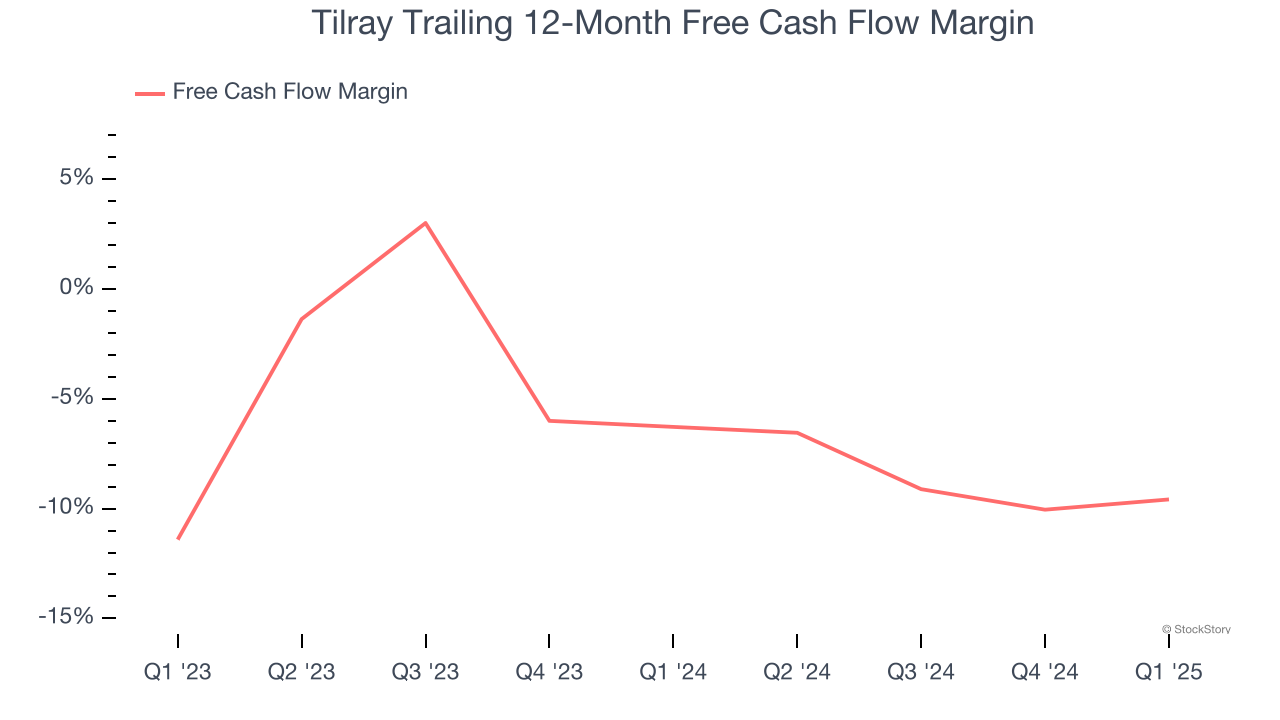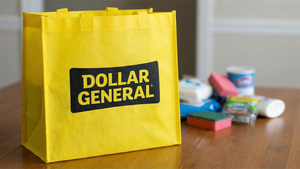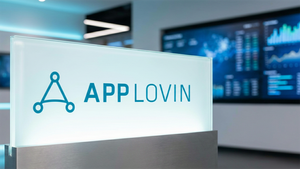
Cannabis company Tilray Brands (NASDAQ: TLRY) fell short of the market’s revenue expectations in Q1 CY2025, with sales falling 1.4% year on year to $185.8 million. The company’s full-year revenue guidance of $875 million at the midpoint came in 2% below analysts’ estimates. Its non-GAAP loss of $0 per share was significantly above analysts’ consensus estimates.
Is now the time to buy Tilray? Find out by accessing our full research report, it’s free.
Tilray (TLRY) Q1 CY2025 Highlights:
- Revenue: $185.8 million vs analyst estimates of $206.6 million (1.4% year-on-year decline, 10.1% miss)
- Adjusted EPS: $0 vs analyst estimates of -$0.03 (significant beat)
- Adjusted EBITDA: $9.04 million vs analyst estimates of $9.97 million (4.9% margin, 9.3% miss)
- Operating Margin: -409%, down from -43.6% in the same quarter last year due to ~$700 million of non-cash impairment as a result of macroeconomic conditions and declines in market capitalization, foreign exchange loss, amortization, changes in fair value of convertible notes receivable
- Free Cash Flow was -$19.97 million compared to -$24.09 million in the same quarter last year
- Market Capitalization: $543.2 million
Irwin D. Simon, Chairman and Chief Executive Officer of Tilray Brands, stated, "Tilray Brands is shaping the future of consumer markets with a robust global infrastructure spanning the beverage, cannabis, and wellness industries. We are meeting the needs of today’s consumers while preparing for the demands of tomorrow. In the third quarter, we prioritized sales quality and revenue, protected margins, reduced debt, and improved our capital structure. With a strong balance sheet and a clear vision for the future, Tilray is well positioned to capitalize on emerging opportunities and ensure long-term success.”
Company Overview
Founded in 2013, Tilray Brands (NASDAQ: TLRY) engages in cannabis research, cultivation, and distribution, offering a range of medical and recreational cannabis products, hemp-based foods, and alcoholic beverages.
Beverages, Alcohol, and Tobacco
These companies' performance is influenced by brand strength, marketing strategies, and shifts in consumer preferences. Changing consumption patterns are particularly relevant and can be seen in the rise of cannabis, craft beer, and vaping or the steady decline of soda and cigarettes. Companies that spend on innovation to meet consumers where they are with regards to trends can reap huge demand benefits while those who ignore trends can see stagnant volumes. Finally, with the advent of the social media, the cost of starting a brand from scratch is much lower, meaning that new entrants can chip away at the market shares of established players.
Sales Growth
Reviewing a company’s long-term sales performance reveals insights into its quality. Even a bad business can shine for one or two quarters, but a top-tier one grows for years.
With $826.7 million in revenue over the past 12 months, Tilray is a small consumer staples company, which sometimes brings disadvantages compared to larger competitors benefiting from economies of scale and negotiating leverage with retailers. On the bright side, it can grow faster because it has a longer list of untapped store chains to sell into.
As you can see below, Tilray grew its sales at a decent 10.2% compounded annual growth rate over the last three years. This shows its offerings generated slightly more demand than the average consumer staples company, a useful starting point for our analysis.

This quarter, Tilray missed Wall Street’s estimates and reported a rather uninspiring 1.4% year-on-year revenue decline, generating $185.8 million of revenue.
Looking ahead, sell-side analysts expect revenue to grow 12% over the next 12 months, an acceleration versus the last three years. This projection is noteworthy and indicates its newer products will spur better top-line performance.
Today’s young investors won’t have read the timeless lessons in Gorilla Game: Picking Winners In High Technology because it was written more than 20 years ago when Microsoft and Apple were first establishing their supremacy. But if we apply the same principles, then enterprise software stocks leveraging their own generative AI capabilities may well be the Gorillas of the future. So, in that spirit, we are excited to present our Special Free Report on a profitable, fast-growing enterprise software stock that is already riding the automation wave and looking to catch the generative AI next.
Cash Is King
Free cash flow isn't a prominently featured metric in company financials and earnings releases, but we think it's telling because it accounts for all operating and capital expenses, making it tough to manipulate. Cash is king.
Tilray’s demanding reinvestments have drained its resources over the last two years, putting it in a pinch and limiting its ability to return capital to investors. Its free cash flow margin averaged negative 8%, meaning it lit $8.02 of cash on fire for every $100 in revenue.
Taking a step back, we can see that Tilray’s margin dropped by 3.3 percentage points over the last year. Almost any movement in the wrong direction is undesirable because it is already burning cash. If the trend continues, it could signal it’s in the middle of an investment cycle.

Tilray burned through $19.97 million of cash in Q1, equivalent to a negative 10.8% margin. The company’s cash burn was similar to its $24.09 million of lost cash in the same quarter last year.
Key Takeaways from Tilray’s Q1 Results
We liked how Tilray beat analysts’ EPS expectations this quarter. On the other hand, its revenue missed significantly and its EBITDA fell short of Wall Street’s estimates. Overall, this was a softer quarter. The stock traded down 1.7% to $0.57 immediately following the results.
Tilray’s earnings report left more to be desired. Let’s look forward to see if this quarter has created an opportunity to buy the stock. We think that the latest quarter is only one piece of the longer-term business quality puzzle. Quality, when combined with valuation, can help determine if the stock is a buy. We cover that in our actionable full research report which you can read here, it’s free.





